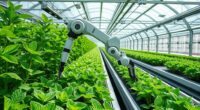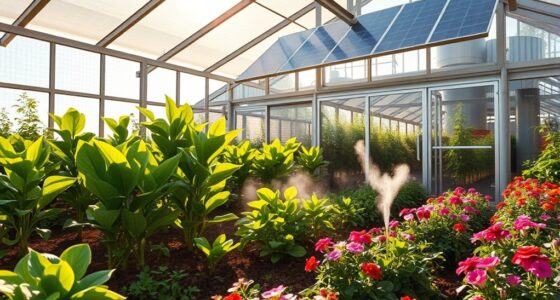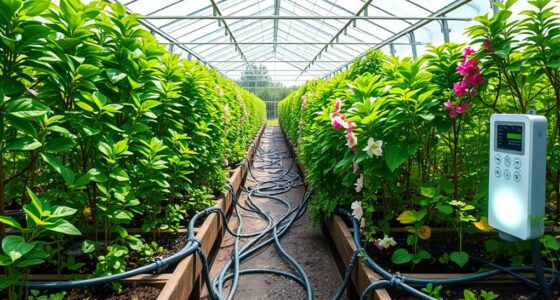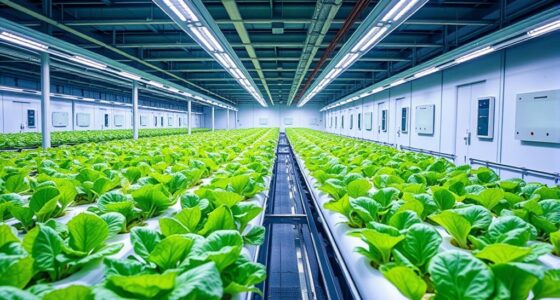High-tech glass for greenhouses uses nanomaterials to optimize light transmission, boost energy efficiency, and protect plants. It blocks unwanted UV rays while allowing ideal visible light, helping plants grow better. The glass can also regulate temperature by reflecting infrared radiation, reducing energy costs. Its durability and self-cleaning features mean less maintenance and longer lifespan. If you keep exploring, you’ll discover even more ways these innovations can transform greenhouse environments.
Key Takeaways
- Nanomaterials enable dynamic light regulation, blocking UV rays while maximizing visible light for plant growth.
- Advanced glazing reflects infrared radiation, improving thermal insulation and reducing energy use.
- Self-cleaning nanostructures maintain high light transmission with minimal maintenance.
- Enhanced durability from nanotechnology extends glass lifespan, lowering replacement costs.
- Innovations in material science optimize greenhouse environments for efficiency and sustainability.

Have you ever wondered how modern glass combines transparency with advanced functionality? It’s a marvel of engineering that’s transforming greenhouses into highly efficient environments. Thanks to nanotechnology applications, high-tech glass now offers features that were once unimaginable. Tiny nanomaterials are embedded within the glass, enabling it to perform multiple roles simultaneously. For instance, these nanoparticles can control light transmission, blocking unwanted UV rays while allowing ideal visible light to pass through, maximizing plant growth. This precision helps create the perfect climate inside your greenhouse, promoting healthier plants and higher yields.
One of the key benefits of these innovations is the enhanced thermal insulation properties of high-tech glass. Traditional glass tends to let heat escape during colder months and allows excessive heat in summertime, forcing you to rely heavily on climate control systems. Modern glass, however, acts as a barrier against unwanted temperature fluctuations. By incorporating nanomaterials, the glass can reflect infrared radiation, which keeps heat in during winter and out during summer. This results in more stable internal temperatures, reducing energy costs and making your greenhouse more sustainable. The improved thermal insulation also contributes to better humidity control, creating an environment where plants can thrive without constant manual adjustments. Energy efficiency plays a crucial role in sustainable greenhouse design, making these innovations increasingly valuable. Additionally, the durability and longevity of materials are enhanced by nanotechnology, helping to extend the lifespan of greenhouse structures. Advances in material science continue to drive these advancements forward, offering even more possibilities for greenhouse technology. Furthermore, the integration of dog breeds knowledge can inspire innovative design solutions that enhance durability and adaptability in various environmental conditions. The applications of nanotechnology extend beyond just temperature regulation. They enable the glass to be self-cleaning by breaking down dirt and organic materials when exposed to sunlight. This keeps your greenhouse glass clear and maximizes light transmission without frequent cleaning. Additionally, the same nanostructures can help block harmful ultraviolet rays, protecting delicate plants from damage and reducing the need for chemical treatments. Some high-tech glass even features dynamic properties, adjusting its transparency in response to changing sunlight levels, which further optimizes light efficiency inside the greenhouse. Furthermore, integrating advanced materials into the glass enhances its durability and longevity, reducing maintenance costs over time.
Frequently Asked Questions
How Does High-Tech Glass Impact Indoor Temperature Regulation?
You’ll notice that high-tech glass greatly improves indoor temperature regulation by enhancing thermal insulation, which keeps heat inside during winter and outside in summer. Additionally, it offers UV filtration, protecting your space from harmful rays while reducing cooling costs. This smart glazing helps maintain a comfortable environment, lowers energy consumption, and creates a more controlled indoor climate, making it an efficient choice for sustainable building design.
What Are the Maintenance Requirements for Advanced Greenhouse Glazing?
Imagine your greenhouse as a delicate ecosystem that needs your care. You should follow consistent cleaning protocols to keep advanced glazing clear and maximize light transfer. Regular inspections help detect damage early, preventing costly repairs. Avoid harsh chemicals to prevent damage, and handle panels gently during maintenance. By staying proactive, you assure your high-tech glass remains efficient and durable, giving your plants the best environment to thrive.
Can High-Tech Glass Be Customized for Specific Crop Needs?
You can definitely customize high-tech glass for specific crop needs. By applying crop-specific coatings, you optimize light transmission for particular plants, enhancing growth and yields. Tailored translucency allows you to control how much light enters, matching the crop’s requirements. This customization helps create an ideal environment, ensuring your plants get the precise light spectrum they need while maximizing energy efficiency.
What Is the Lifespan of Innovative Greenhouse Glazing Materials?
Did you know that innovative greenhouse glazing materials often have a durability lifespan of 15 to 25 years? You’ll find that material longevity varies depending on the type of glass and environmental conditions, but many high-tech options are designed to withstand harsh weather and UV exposure. This durability guarantees you get long-term benefits, reducing replacement costs and maintaining ideal light efficiency over time.
How Does High-Tech Glass Contribute to Sustainable Energy Use?
High-tech glass helps you use solar energy more efficiently by maximizing light transmission and reducing heat loss. This means your greenhouse consumes less energy for heating and cooling, lowering your environmental impact. By harnessing more natural light, you reduce reliance on artificial lighting and fossil fuels. Overall, high-tech glass supports sustainable energy use, making your greenhouse more eco-friendly and cost-effective while promoting a healthier environment.
Conclusion
You can harness high-tech glass to boost light efficiency, to improve plant growth, and to reduce energy costs. You can embrace innovation, adapt to changing needs, and open new potential for your greenhouse. You can invest in smarter glazing, optimize your environment, and foster sustainable practices. By choosing advanced glass, you take control of your greenhouse’s future—enhancing productivity, conserving resources, and shaping a greener tomorrow.










